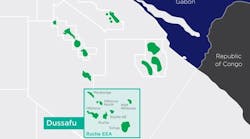Geoscientists got an early look at the latest state-of-the-art CoreFlow digital rock and fluid analytics services offered by the Schlumberger Reservoir Laboratory in Houston. The laboratory currently houses the rock analysis group, soon to be joined by the reservoir fluids analysis group. It is a powerful combination that should be able to answer anyone's questions about what is in the reservoir, and suggest the best ways to get it out.
A three-level process
According to the company, CoreFlow services can be applied to all reservoir types including carbonates, sandstones, and shale. Beginning with whole core, experts perform whole-core dual-energy computed tomography (CT) scanning. The process can be applied while the core is still inside its aluminum or plastic protective sleeve, in case it may be fractured or friable. Alternatively, the core can be deep-frozen to maintain its mechanical integrity while it undergoes preliminary analysis. The helical CT scanner can examine core cross sections as close together as 0.5 mm along the length of the entire core. Adjacent slice images are woven into a "motion picture" for display quite like an electronic version of the "flip books" we all had when we were children. The film of the whole core can be used to select specific locations for further laboratory or digital analysis.
The next level is digital core micro-CT imaging and analysis. Using a distinct sample, in this case 8.0 mm in diameter, the process unites digital and physical data. At this level, for example, the porosity of the sample can be directly compared with routine analysis measurements because the sample is large enough. Conversely, the sample is small enough to capture micro-CT images of pores and grains with 1 micron resolution or better.
At the nanometer level, scanning electron microscope (SEM) imaging provides 2D and 3D images. A thin slice is planed using an Argon-ion mill for this level of imaging. For conventional reservoirs, this level of magnification is useful for evaluation of micro-porosity. For unconventional reservoirs such as shales, features as tiny as nanopores can be imaged to provide texture that can indicate producibility. A focused ion beam (FIB) SEM measures pore interconnectivity. 3D cubes can be generated and detailed examinations performed using digital slice imaging. After donning 3D glasses, employees and visitors can take a visual tour through a virtual maze of micropores. Critical impediments to production such as microscopic particles that block pore throats can be identified.
The ultimate tool
For total rock and fluid analysis, a DHD digital hydrodynamics simulator is used. According toSchlumberger scientists, this is the major game-changer in core flow analysis. The simulation is a combination of both digital rock and digital fluid based on laboratory measurements of fluid properties. Such parameters as capillary pressure and relative permeability can be determined for any specific reservoir. Simulations can be combined with lab measurements of the properties to obtain better answers faster.
The fluid analysis group is presently located elsewhere in Houston, but will relocate permanently to the new facility to establish a more synergistic environment and one more attuned to the realism that is rock/fluid interaction in the reservoir.
Today fluid characterization is performed using phase diagram progression where pressure and temperature can be varied to study phase behavior. Not only is this a key to understanding hydrodynamics, it is also the gateway to understanding flow assurance issues. Using mercury-free pressure-volume-temperature (PVT) systems, all fluid types can be analyzed including black oil, heavy oil, gas condensate, waxy and asphaltenic fluid and hydrates. Accurate equation-of-state (EOS) modeling can be performed leading to better reserves calculation and production optimization.
Comprehensive fluid characterization includes reservoir fluid compositional analysis, geochemical studies, water properties, well site chemistry, and sample management in addition to the aforementionedflow assurance studies.
Total reservoir characterization
Co-locating rock and fluid analysis functions promises the potential to crack the enhanced oil recovery (EOR) code. For more than a century, oil and gas producers have endeavored to improve recovery of oil they have already discovered. Increases in the fraction of recoverable hydrocarbons have been disappointing. Still, as much as 65% of oil-in-place in reservoirs is unrecoverable using today's techniques.
The value of integrated rock and fluid analysis, both physically and digitally, will have its greatest effect on EOR. Success depends upon finding the dominant factors that determine oil displacement efficiency in the reservoir.
An effective program will be one that sheds a light on the forces keeping the oil in the pores versus the effect of injected displacement fluid and their interaction. Heretofore, many enhanced recovery schemes used a trial and error approach. Sadly, many trials irreversibly damaged the reservoir network. The errors were costly.
With digital hydrodynamics analyses, it may be possible to solve the residual hydrocarbon paradox using simulation, eliminating failed trials and costly errors.







